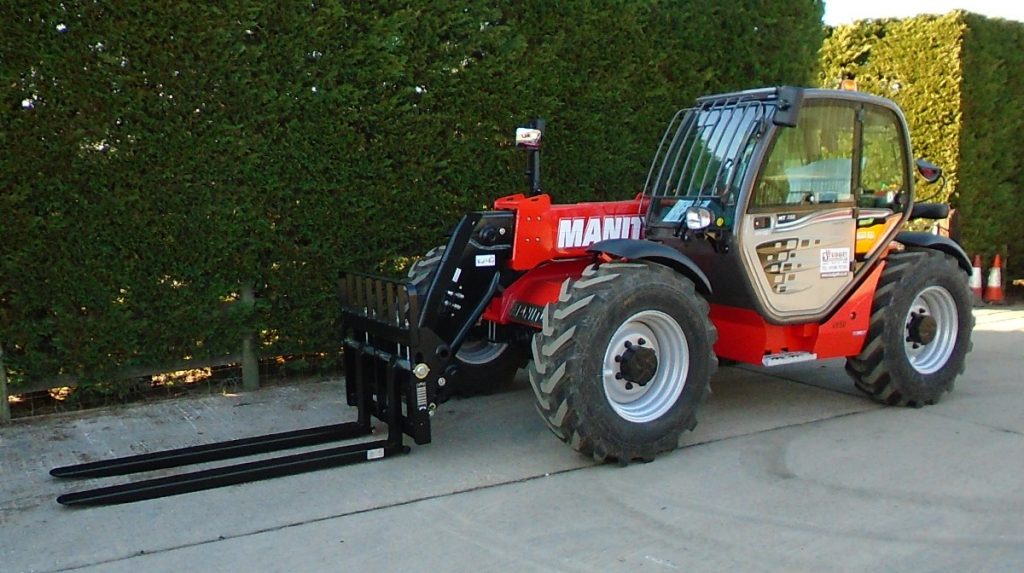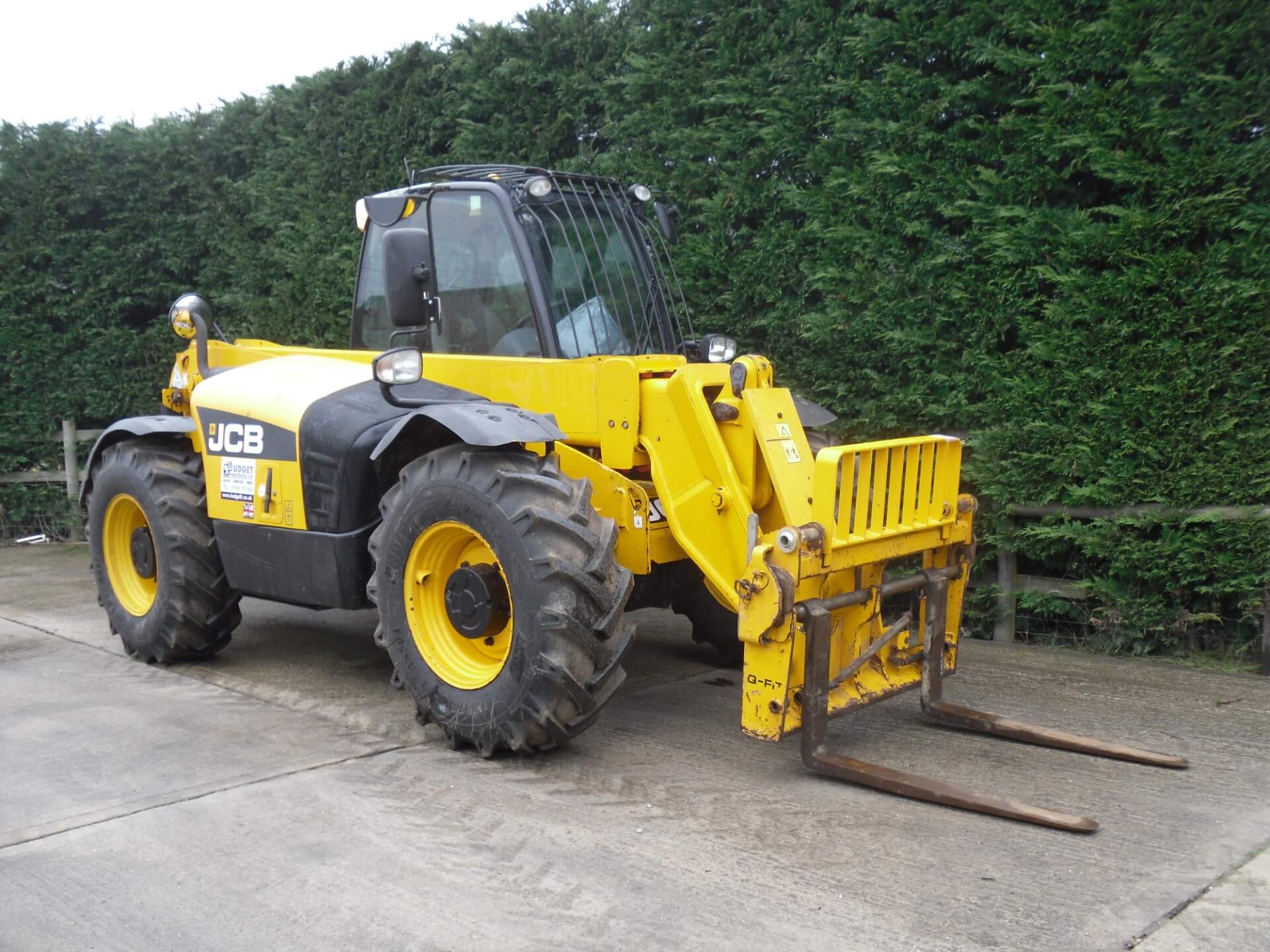A telehandler, also known as a telescopic handler, forklift is a hugely versatile lifting machine that is most often used in the construction industry. They feature telescopic arms that can lift loads and extend/retract to adjust the maximum reach/lifting height of the machine. Their primary use is for lifting pallet boards, and they can move heavy loads into high up areas that are tough to reach any other way.
For the most part, modern telehandler forklifts incorporate various capabilities, boosting their efficiency in a number of different jobs. Most are fitted with a telescopic boom that can accommodate a variety of lifting attachments and equipment to suit appropriate jobs. They also include features that make them suitable for a diverse range of terrains and environments, amplifying their versatility and helping workers in many industries get on-site processes completed quickly, safely and efficiently.
Most machines can replicate the functions of forklifts, cranes and elevated work platforms (by attaching a platform to the telehandler boom). This is made possible by a design element called a ‘quick hitch’, essentially to enable the operator to alternate from one attachment to the next in a swift and safe way. This minimises the time and effort associated with transporting heavy loads and cuts down the time it takes to carry out big tasks that would otherwise require multiple machines.
Attachments for telehandlers
There are many attachments available for telehandlers, each designed for specific tasks, many of which are industry-specific. It can sometimes be hard to ascertain which is the right attachment for the job. Think about what’s required in the project you are undertaking, and what you aim to achieve at the end of it. Quality telehandler models will emphasise durability and versatility and will have a good range of attachments available to ensure no job is beyond its capabilities.
The most common telehandler forklift attachment is the fork carriage, which essentially transforms the machine into a multi-functional workhorse that can lift a wide range of loads, such as:
- Concrete blocks
- Pallets
- Steel bars
- Timber
- Industrial pipes
- Packaged goods
The available attachments come in a wide selection of forms and sizes, so it’s important to make a comprehensive assessment about what your project requires and also how an attachment would fit your telehandler. A good dealership should be able to advise you on this, so make use of their expertise where you can.

Crane jib attachments
The crane jib is another of the most popular attachments for the telehandler forklift. It transforms your machine into a kind of crane for picking and carrying, lifting extremely heavy loads and moving them around a site where conventional forklifts are either not permitted or simply not up to the task. It can be more efficient and effective to use a telehandler than hire a large crane on-site, but you need to assess this on a site-by-site basis.
If your aim is to lift and move loose materials like sand, water or anything else prone to toppling, it is probably best to use buckets. These can be secured and lifted using the crane jib attachment on your telehandler forklift and will help minimise any spillage while lifting these types of heavy load.
The compact telehandler
Compact models, as you might expect, are smaller and more versatile. They can be used to lift and move heavy loads around the site. They combine the functions of a conventional forklift with the extra power and reach of a telehandler. There are various models of compact telehandler available, each designed for different environments and featuring different strengths and weaknesses, as well as their own range of attachments. Again, it’s recommended that you do your research before deciding on which compact telehandler to go with.
How much can be lifted with a telehandler?
Different telehandlers are built differently, meaning every telehandler is built to lift a load that is appropriate for its size. So, in general, it’s safe to say that the larger a telehandler is, the heavier loads it will be able to lift, and there are extreme models available for the heaviest loads. There are, however, some common maximum lift capacities associated with standard models, and this ranges from 4,400 lbs (2,000 kg) to 12,000 lbs (5,445 kg).
Keep in mind that you will not be able to lift a load that is the telehandler’s maximum lift capacity all the way to its maximum reach/height. This is likely to put too much strain on the machine, which increases the risk of accidents and damage. Every telehandler will come with its own guidelines on lifting different loads, so be sure to follow instructions on this front. These guidelines are developed through testing, so they exist for a reason, and you should never question their accuracy.
Understanding your telehandler
Here are some common terms you will encounter that relate to your telehandler forklift:
Forward reach – most smaller telehandlers have a maximum forward extension of around 10 feet. Larger models, on the other hand, can reach lengths as much as 45 feet in some cases, which can be really useful in certain situations.
Engine size – the majority of telehandlers available to rent have diesel engines. The size of your handler will usually dictate the size of its engine; larger machines require more power, so they have bigger engines. You will be able to find out the engine size of different models by viewing the spec or asking the dealer.
Lift heights – there will be variation between different models in terms of the distance you can lift. For example, most 4,400 lb telehandlers aren’t likely to extend beyond 20 feet, while a 10,000 lb model may have lift heights as extensive as 40-60 feet.
Turning radius – this is all about the agility of the telehandler. Compact models are generally simpler to manoeuvre due to their size. Turning radius is an important factor when considering which machine will be best for your work environment.
Steering modes – there are usually 3 steering model for telehandlers:
- Standard/front-wheel
- All-wheel/4-wheel
- Crab wheel
Standard steering is best for operating on sites that have level surfaces and minimal clutter. Alternatively, 4-wheel telehandlers can manoeuvre in tighter spaces for sites where space is at a premium. Crab-steering is best to help shift loads into those hard-to-reach areas, where precise placing is required.
The hydraulic functions of a telehandler
There are typically 6 hydraulic functions a telehandler can perform:
Boom lift up/down – this moves the telescopic boom upwards and downwards.
Boom extend/retract – this extends and retracts the telescopic boom.
Tilt fork up/down – tilt the forks forwards and backwards.
Stabilisers up/down – extend and retract the stabilisers.
Steering – this covers the 3 steering types mentioned in the previous section.
Frame levelling – this levels the machine when on an unstable surface, using the axle.
Telehandlers have wide, off-road tyres designed for use on almost any terrain. This means they are useful for a variety of industries, including the challenging environments of the agricultural sector. When lifting heavy loads, the stabilisers ensure the machine maintains a stable stance so that loads can be extended as far as possible.
Telehandler types
A fixed telehandler has a fixed cab alongside a telescopic boom. The cab can’t rotate, but the machine is extremely robust – this type of telehandler is best used when you have to shift extremely heavy loads. A rotating telehandler, on the other hand, features a cab and telescopic boom that can rotate through 360°. The machine remains stationary while the cab and boom rotate around the axis, helping with manoeuvrability and getting to hard-to-reach places.
Selecting the right type of telehandler for you means considering a few key factors. Different sectors and lines of work are better suited to different types of telehandler. Ask yourself the following questions:
Which sector will you be using the telehandler in? Do you need to know more about use in agriculture? Or perhaps construction is more your field?
Will you only be using the telehandler in sporadic cycles to lift light loads? Or will you use it to shift heavy loads over long distances?
These are the types of questions that you need to be asking yourself. Establish your needs, and work out which type of telehandler is best suited to serve your purpose. There is plenty of information online to help inform your decision, and a good dealership will be able to advise you on what will work best.


